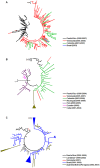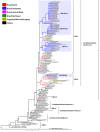Origin and evolution of dengue virus type 3 in Brazil
- PMID: 22970331
- PMCID: PMC3435237
- DOI: 10.1371/journal.pntd.0001784
Origin and evolution of dengue virus type 3 in Brazil
Abstract
The incidence of dengue fever and dengue hemorrhagic fever in Brazil experienced a significant increase since the emergence of dengue virus type-3 (DENV-3) at the early 2000s. Despite the major public health concerns, there have been very few studies of the molecular epidemiology and time-scale of this DENV lineage in Brazil. In this study, we investigated the origin and dispersion dynamics of DENV-3 genotype III in Brazil by examining a large number (n=107) of E gene sequences sampled between 2001 and 2009 from diverse Brazilian regions. These Brazilian sequences were combined with 457 DENV-3 genotype III E gene sequences from 29 countries around the world. Our phylogenetic analysis reveals that there have been at least four introductions of the DENV-3 genotype III in Brazil, as signified by the presence of four phylogenetically distinct lineages. Three lineages (BR-I, BR-II, and BR-III) were probably imported from the Lesser Antilles (Caribbean), while the fourth one (BR-IV) was probably introduced from Colombia or Venezuela. While lineages BR-I and BR-II succeeded in getting established and disseminated in Brazil and other countries from the Southern Cone, lineages BR-III and BR-IV were only detected in one single individual each from the North region. The phylogeographic analysis indicates that DENV-3 lineages BR-I and BR-II were most likely introduced into Brazil through the Southeast and North regions around 1999 (95% HPD: 1998-2000) and 2001 (95% HPD: 2000-2002), respectively. These findings show that importation of DENV-3 lineages from the Caribbean islands into Brazil seems to be relatively frequent. Our study further suggests that the North and Southeast Brazilian regions were the most important hubs of introduction and spread of DENV-3 lineages and deserve an intense epidemiological surveillance.
Conflict of interest statement
The authors have declared that no competing interests exist.
Figures





References
-
- Gubler DJ (2002) Epidemic dengue/dengue hemorrhagic fever as a public health, social and economic problem in the 21st century. Trends Microbiol 10: 100–103. - PubMed
Publication types
MeSH terms
Substances
LinkOut - more resources
Full Text Sources
Medical

